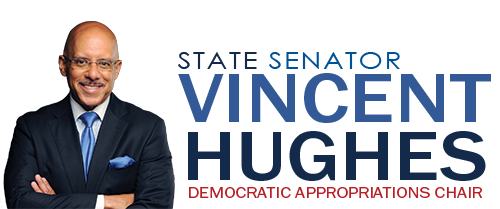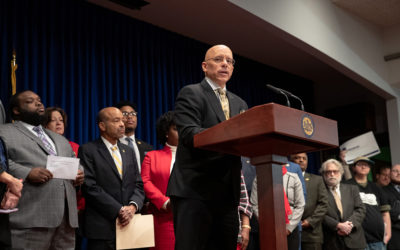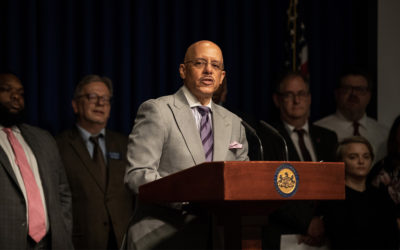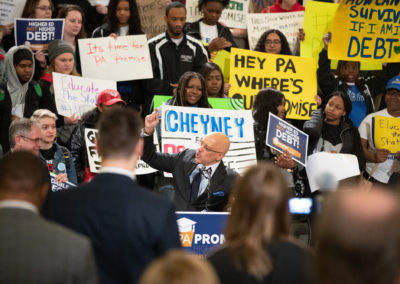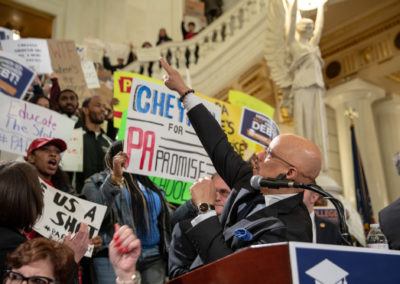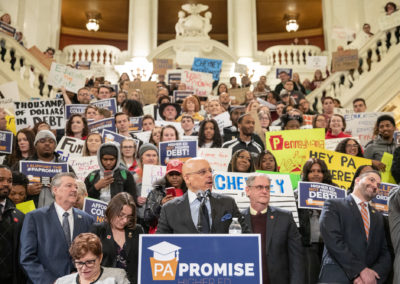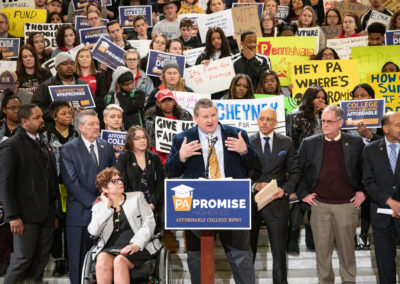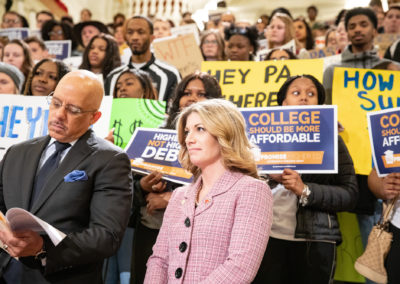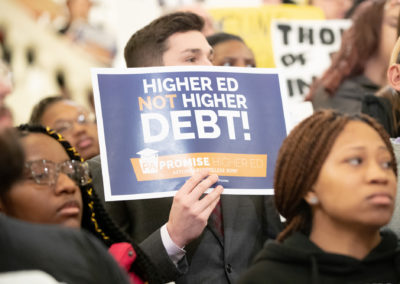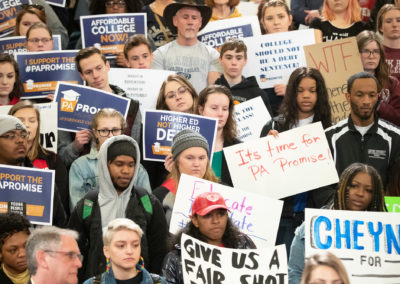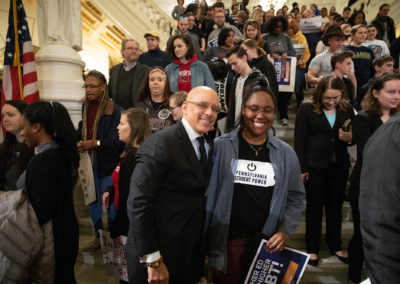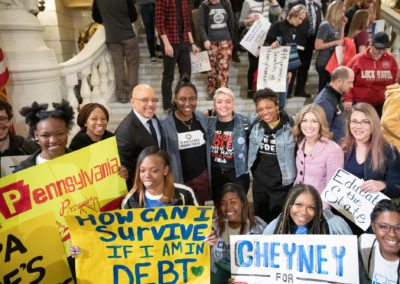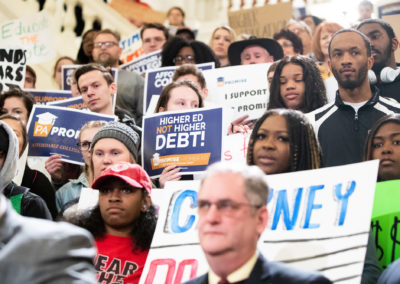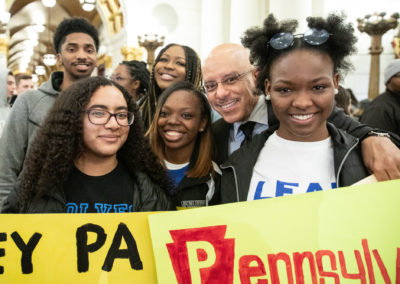
Pennsylvania Promise
Free and Affordable Education for All
One of the most troubling challenges facing many students and families across Pennsylvania is the high cost of education. This is often such a high hurdle that many students simply forgo a college education and are prevented from acquiring the skills necessary to gain better positions with higher wages.
The education gap caused by a lack of access to college or advanced education is, for many low-and-middle income students, the one faction preventing them from gaining traction in the workplace. In our increasingly complex and high-tech economy, it is essential that we make, then fulfill, the promise to Pennsylvania students: YOU will have access to a high-quality education without the burdens of crippling debt.
That’s what the Pennsylvania Promise is all about. The Pennsylvania Promise is available to students with family incomes of $110,000 or less. It provides for grants of at least $1,000 per year for community college students for two years and a minimum of $2,500 per year for four years to Pennsylvania State System of Higher Education Schools and state related institutions.
The program also provides $50 million for adults in families whose incomes are less than $110,000 to acquire up to four years of postsecondary credit.
Help us make the Pennsylvania Promise a promise fulfilled.
-
- Contact your legislators and tell them to support Pennsylvania Promise. (Click here to look up your elected officials.) Not sure what to say? Click here for sample messages.
- Sign our petition calling for Gov. Tom Wolf to support Pennsylvania Promise legislation.
- Spread the positive message about Pennsylvania Promise on Facebook, Twitter, and Instagram using #PApromise. You can even add a #PApromise overlay to your Facebook profile photo.
- Attend a Pennsylvania Promise rally.
- Organize your own rally or house party. Email info@PApromise.org to get started.
- Share your higher-education story. Click here to submit information.
- Give. Whether you can contribute $1 or $1,000, you can help make higher education affordable in Pennsylvania.
Video
What Does Pennsylvania Promise Mean To Us
WITH,  OUR COMMONWEALTH COULD:
OUR COMMONWEALTH COULD:

Cover two years of tuition and fees for any recent high school graduate enrolled full-time at one of the Commonwealth’s 14 public community colleges

Provide four years of tuition and fees not to exceed the State System tuition rate, depending on family income, for students accepted into a state-related university

Cover four years of tuition and fees for any recent high school graduate with a family income less than or equal to $110,000 per year accepted into one of the 14 universites in Pennsylvania’s State System of Higher Education

Finance the expansion of grant assistance to adults seeking in-demand skills and industry-recognized credentials, as well as college credit
Pennsylvania Promise
Latest News
Senator Hughes declares “Higher Education Affordability Week” at Pa. Capitol
Harrisburg – March 25, 2019 – Renewing his commitment to addressing growing student debt and soaring college tuition costs, Senator Vincent Hughes (D-Philadelphia/Montgomery) will introduce a resolution declaring March 25-29 “Higher Education Affordability Week.” Sen....
Free college! Time for a New Deal for Pa. college students
Senator Hughes renewed his push for the Pennsylvania Promise initiative, a drive to bring free college to all Pennsylvanians, through Senate Bill 111 on Jan. 30. The PA Promise would also provide funding for those pursuing apprenticeships, trades and adult...
Sen. Hughes, Reps. Harris and Roebuck renew push for free college
Harrisburg — January 30, 2019 — Renewing their call for free college for all Pennsylvanians, Senator Vincent Hughes, (D-Philadelphia/Montgomery), Rep. Jordan Harris (D-Philadelphia), Rep. James Roebuck (D-Philadelphia) and APSCUF President Ken Mash announced the next...
Senator Hughes to renew call for free college Wednesday
Harrisburg, Pa. – At 9:30 a.m. Wednesday, Jan. 30 in the Capitol Media Center, Senator Hughes will be joined by legislators and education officials to renew the call for free college through the Pennsylvania Promise. The press conference will also provide...
Senator Hughes Holds Press Conference to Introduce the Pennsylvania Promise Initiative
Senator Hughes, Representatives Roebuck and Harris Introduce Legislation Pushing for Free and Affordable College
HARRISBURG – June 6, 2018 – Senator Vincent J. Hughes (D-Philadelphia/Montgomery), Representative James Roebuck (D-Philadelphia), and Representative Jordan Harris (D-Philadelphia) introduced legislation for the Pennsylvania Promise initiative, a program that would...
Debt in America: An Interactive Map
Credit can be a lifeline during emergencies and a bridge to education and homeownership. But debt, which can stem from credit or unpaid bills, often burdens families and communities and exacerbates wealth inequality. This map shows the geography of debt in America at the national, state, and county levels. How does your community compare?
A Third of College Students Face Food and Housing Insecurity
TEEN VOGUE | BY ELLY BELLE | APRIL 5, 2018
Paying for college tuition and the textbooks and materials needed for classes can be hard enough. Whether you attend college part time or full time or go to community college or a university, it can be difficult to scrape together money for food and housing. Add on trying to maintain a social life and it can feel downright impossible. However, there hasn’t been much comprehensive data about just how much food insecurity, housing insecurity, and homelessness affect college students nationwide.
The Hidden Crisis on College Campuses: Many Students Don’t Have Enough to Eat
THE WASHINGTON POST | BY CAITLIN DEWEY | APRIL 3, 2018
Caleb Torres lost seven pounds his freshman year of college — and not because he didn’t like the food in the dining hall. A first-generation college student, barely covering tuition, Torres ran out of grocery money halfway through the year and began skipping meals as a result. He’d stretch a can of SpaghettiOs over an entire day. Or he’d scout George Washington University campus for events that promised free lunch or snacks. Torres told no one what he was going through, least of all his single mom.
Senator Hughes Joins the Call for Affordable Higher Education For All Pennsylvania Students
Harrisburg, PA – January 23, 2018 – Senator Vincent Hughes spoke today in support of affordable higher education for Pennsylvanians. Standing with advocates and researches from the Association of State College & University Faculty, Keystone Research Center,...
Senator Hughes Remarks on “Pennsylvania Promise”, a plan to make college affordable for all Pennsylvania students
Video
Their Stories
Keeping the Promise
Legislation
Senate Bill 111 and House Bill 244:
The bills aim to make higher education free or affordable at public community colleges, Pennsylvania’s State System of Higher Education (PASSHE) and state-related universities that receive state funding. Pennsylvania Promise would be available to recent high school graduates as well adults seeking in-demand skills and industry-recognized credentials, as well as college credit. The goal of the program is to reduce student debt and assist low and middle-income families with paying for higher education.
Why we need The Pennsylvania Promise
Pennsylvania ranks 40th in the nation for the share of adults with an education beyond high school
According to the Institute for College Access and Success, 70 percent of Pennsylvania students graduate with college debt
The per capita funding for higher education in Pennsylvania ranks 47th in the nation
Every student who is accepted to a school and has been reviewed for appropriate federal, state and institutional grants has an option to fund the “last dollars” and get that student into school
Low income graduates borrow at far higher rates (and higher amounts) than middle or upper income graduates
Research estimates that by 2020, 63 percent of new jobs in Pennsylvania will require some level of higher education. Currently only 40 percent of Pennsylvania residents have a higher education degree.
A 2013 Brookings Institute study showed that many high-achieving students from low-income families do not apply to some college or universities because of cost;
This proposal is in line with what New York, Tennessee and Oregon have done and can reduce debt for Pennsylvania students.
A 2015 study found that increased college costs reduce minority enrollment. A $1,000 tuition and fee increase would reduce minority enrollment by more than 2.5 percent
In 2008, students and families paid approximately 36 percent of the cost of public college, by 2014 they paid approximately 50 percent.
